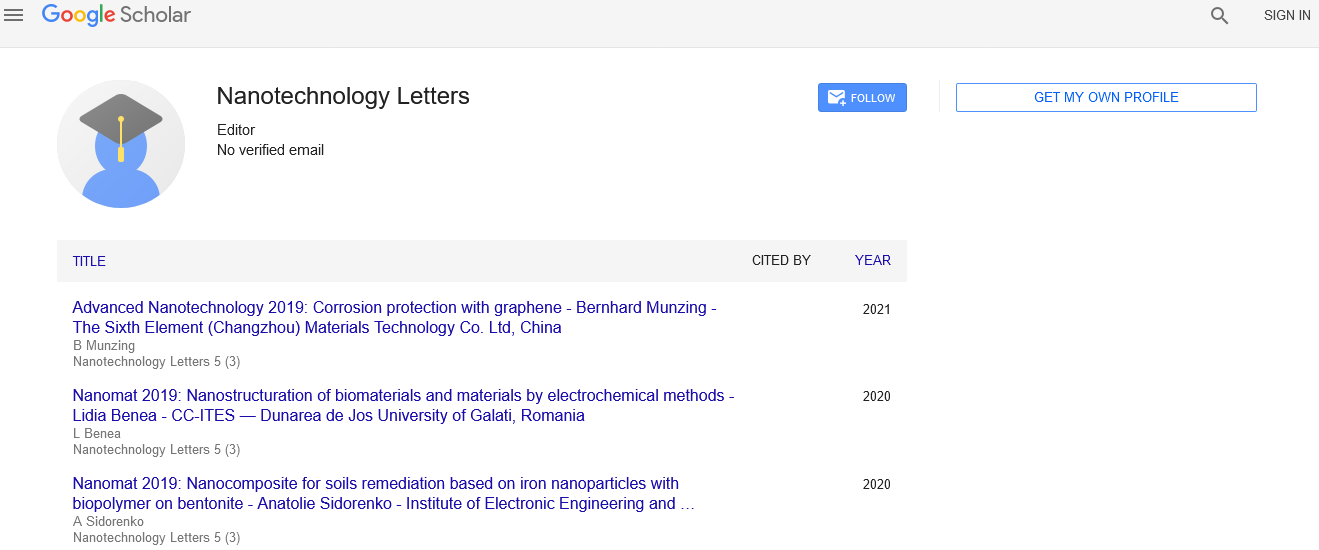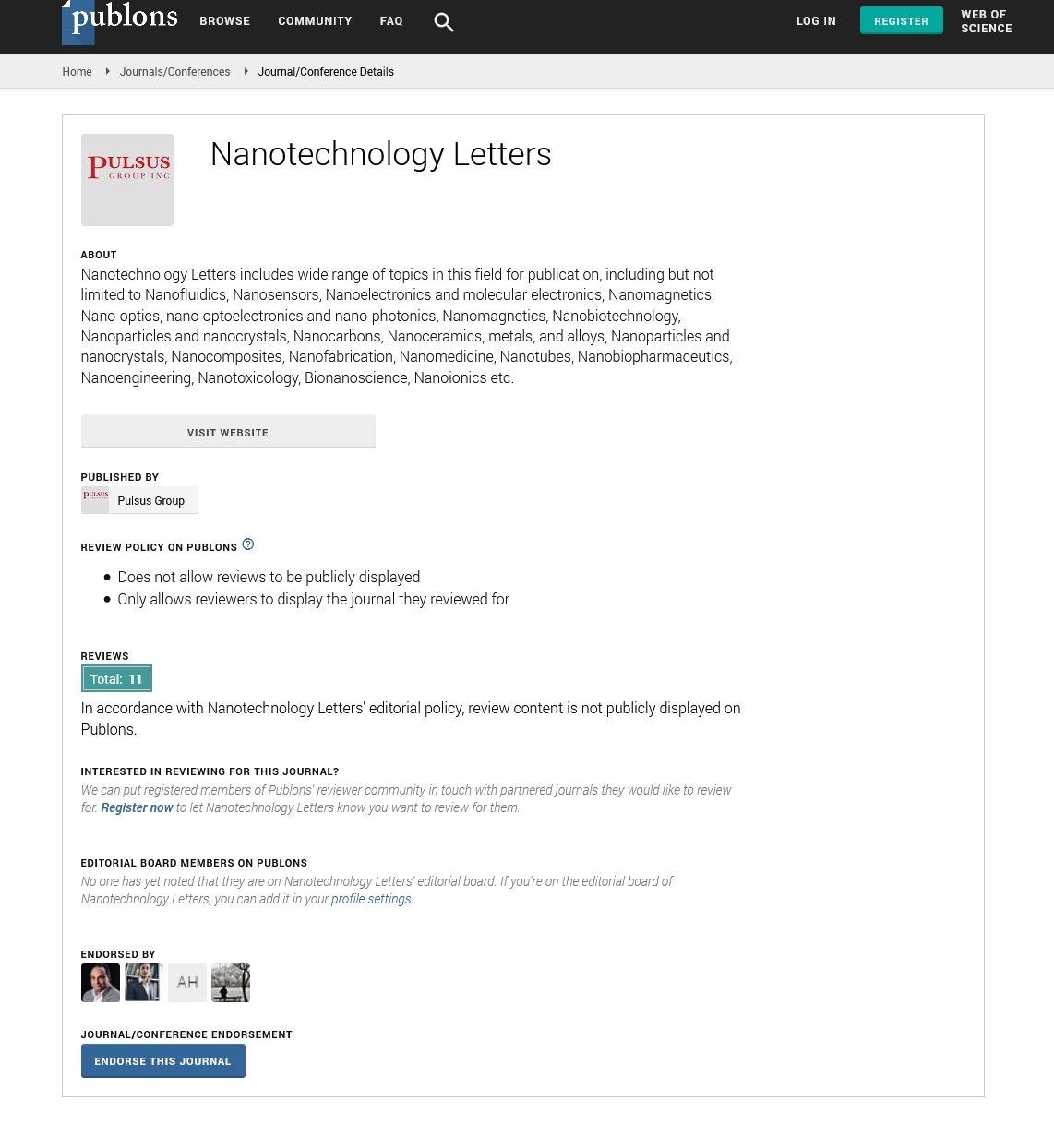Antimicrobial nanomaterials
Received: 05-Nov-2022, Manuscript No. PULNL-22- 5835; Editor assigned: 08-Nov-2022, Pre QC No. PULNL-22- 5835 (PQ); Accepted Date: Nov 26, 2022; Reviewed: 12-Nov-2022 QC No. PULNL-22- 5835 (Q); Revised: 15-Nov-2022, Manuscript No. PULNL-22- 5835 (R); Published: 28-Nov-2022, DOI: 10.37532. pulnl.22.7 (6)24-25
Citation: Lockwood E. Antimicrobial nanomaterials. Nanotechnol. lett.; 7(6):24-25
This open-access article is distributed under the terms of the Creative Commons Attribution Non-Commercial License (CC BY-NC) (http://creativecommons.org/licenses/by-nc/4.0/), which permits reuse, distribution and reproduction of the article, provided that the original work is properly cited and the reuse is restricted to noncommercial purposes. For commercial reuse, contact reprints@pulsus.com
Abstract
There is growing interest in using innovative nanostructured materials as antimicrobials as a result of the prevalence of multidrug-resistant microorganisms. Due to their numerous effects on bacterial physiology, metallic nanoparticles like silver, copper, and gold have been used in particular. Many have drawn the conclusion that these nanomaterials pose significant barriers to the development of resistance.
https://blogum.blogaaja.fi/
https://blogum-1.jimdosite.com/
https://blogummm.edublogs.org/
https://blogummm.websites.co.in/
https://blogum18.wordpress.com/
https://benim-blogum.jigsy.com/
https://fuiegs-symbeaurds-build.yolasite.com/
https://blogum-03.webselfsite.net/
https://blogummm.mystrikingly.com/
https://blogum.splashthat.com/
https://blogum3.webnode.com.tr/
https://blogum.odoo.com/
https://blogum.creatorlink.net/
https://whiteseotr1-s-site.thinkific.com/enrollments
https://blogum.estranky.cz/
https://653ba4fbb538c.site123.me/
https://blogum12m.blogspot.com/
https://blogum.hashnode.dev/
https://whiteseoturkey1.wixsite.com/blogum
https://sites.google.com/view/blogummm/
https://codepen.io/blogum
https://blogumm.livejournal.com/
https://wakelet.com/@blogum82816
https://www.homify.com/users/9538383/blogum
https://lessons.drawspace.com/profile/323613/blogum
https://my.desktopnexus.com/blogum/
https://writeupcafe.com/profile/BLOGUM/
https://www.pearltrees.com/blogum
https://www.easyfie.com/blogum
https://pharmahub.org/members/27615/profile
https://www.zupyak.com/u/blogum/posts
https://www.metroflog.co/blogum
https://www.fuzia.com/fz/blogum-blogum
https://tr.pinterest.com/blogum12/
https://my.getjealous.com/blogum
https://micro.blog/blogum
https://www.tumblr.com/blogummm
https://hub.docker.com/u/blogum
https://fire.blogfree.net/?act=Profile&MID=1342323
https://blogum.pixnet.net/blog
https://www.threadless.com/@blogum/activity
https://blogum.neocities.org/
https://blogum12.amebaownd.com/
https://teletype.in/@blogum
https://ubl.xml.org/users/blogum
https://educatorpages.com/site/blogum/
https://blogum.onlc.fr/
Keywords
Antimicrobials; Metals; Acclimation; Adaptation
Introduction
Utilizing synthetic nanoparticles for various antibacterial applications in healthcare and agriculture has garnered a lot of interest. However, a large portion of this research has been done by engineers and chemists who are not completely aware of how biological systems react to novel materials throughout the course of either an evolutionary or physiological time scale. As evidenced by the greater inhibition halo, Soto-Quintero et al. (2017) noted that both hydrogel nanocomposite systems displayed more potent antibacterial activity against P. aeruginosa than against E. coli. This phenomenon may be explained by E. coli's capacity to develop heavy metal resistance, notably for silver.
They used our 2015 research, "Rapid development of silver nanoparticle resistance in Escherichia coli”, to substantiate their assertion. Unfortunately, our findings do not support this assertion, which shows that the authors have a basic misunderstanding of the mechanisms underlying antimicrobial resistance. Citing this instance is not meant to diminish the scientific achievements of these authors, but rather to highlight the fact that mistakes of this nature are still frequently made in materials research, especially when attempting to assess the effectiveness of metallic nanomaterials against microbial growth.
Evolutionary adaptation and physiological acclimatisation
When it is possible, biological organisms can preserve their internal stability and maintain a steady physiological state thanks to a key characteristic known as homeostasis. Iron homeostasis, metal homeostasis, pH homeostasis, membrane and lipid homeostasis are just a few of the homeostatic processes that must be maintained to ensure the survival of the organism.
Microbes have been exposed to metals from the beginning of life on this planet; some are required, but many are harmful to the cells .One metal that is necessary for survival but hazardous when found in large enough concentrations is iron. Bacteria have developed strategies to regulate iron levels by upregulating or downregulating genes involved in a variety of pathways in order to maintain homeostasis. For instance, some organisms secrete high affinity iron chelators to increase absorption in response to iron deficiency, whereas others upregulate the expression of iron detoxifying proteins and genes related to efflux in reaction to toxic iron levels. The ferric uptake regulator protein is essential for the majority of this differential control. For instance, 35 ironrepressed genes regulate 7 iron uptake mechanisms in Escherichia coli. Fur in turn controls each of these. Almost all bacteria have physiology-controlling genes, which enable them to withstand hazardous metal ions (Ag+, Cd2+, Hg2+, Ni2, etc.). Energy dependent efflux is the most often used metal resistance mechanism among microorganisms because many bacteria have metal-sensing transcriptional regulators that can sense both beneficial and poisonous metals. This enables them to adjust to their environments very quickly. Our research on E. coli demonstrated this for both ionic and nanosilver (Ag+) based resistance. Other mechanisms of metal resistance besides an increase in efflux include the expression of metal-binding proteins or enzymatic changes (oxidation, reduction, methylation, and demethylation).
Role of evolution
Researchers who want to understand how a particular nanomaterial will affect microorganisms must take into account the fact that evolution is always taking place in bacterial populations while designing their experiments, and up until now, this has been a shortcoming in the field of material scientists. For instance, Brown et al. used ampicillin functionalized Silver Nanoparticles (AgNP) to lower multidrug resistant Enterobacter aerogenes and Staphylococcus aureus population. With increasing concentrations (4.0 g/mL and 20.0 g/ mL) of AgNP-AMP in their samples, they were able to demonstrate a reduction of the AgNP-AMP treated bacterial strains to 1 Colony Forming Unit (CFU), as opposed to>8 CFU in controls not treated with AgNP-AMP after 8 hours. The authors did not address the likelihood that bacterial strains could develop resistance to the combination therapy of AgNP-AMP, despite the fact that these results first appear to be encouraging. The information they provided makes this possibility clear.For instance, the Vibrio cholera, E. aerogenes, and S. aureus (MRSA) strains only slightly decreased at concentrations of 2.0 g/ mL and 1.0 g/mL compared to the controls (9.19 0.4, 7.48 0.08, 8.67 0.05 compared to controls 9.23 0.04, 9.56 0.01, and 9.06 0.13 respectively, and at 2.0 g/mL for E. aero.precisely when bacteria are exposed to toxic circumstances, The likelihood of resistance evolving is higher at sub Minimum Inhibitory Concentrations (MIC), and there is evidence that this happens frequently in nature. For instance, one study discovered that bacteria (Klebsiella plantacola) isolated from the Kizilirmak river in Turkey exhibited resistance to 11 heavy metals (aluminium, barium, copper, iron, lead, lithium, manganese, nick) and 15 antibiotics (ampicillin, amoxicillin/ clavulanic acid, aztronam, erythromycin, imipenem, oxacillin, pefloxacin, penicillin.
Role of Genome
The use of biological materials "off-the-shelf" is a recurring theme in materials science research. When detailing the synthesis of their AgNPs in zeolite, the characterisation of AgNP-ZM, and the methods they used to conduct DNA expression and gene expression microarrays, for instance, Nagy et al. (2011), despite being excellent mechanistic research, wasted a lot of time. They didn't elaborate on their selection of E. coli XL-1 blue or its genetic traits in relation to the subject they wished to explore. Additionally, given the pleiotropy we have seen in our recent studies, the fact that it carries a tetracycline-resistant plasmid may significantly change the outcomes that they would have seen in a wild type strain. Specific strains of Pseudomonas aeruginosa (ATCC 25922) and Escherichia coli (ATCC 2785) were used by the authors in Soto-Quintero et al. (2017). However, since neither strain is listed in Entrez PubMed nor in the ATCC database, it's plausible that there was a typographical error. Unlike Pseudomonas aeruginosa (ATCC 25922), which is not listed on either the ATCC website or the Entrez Pubmed Database, Escherichia coli strain (ATCC 25922) is present in both the ATCC database and the Entrez Pubmed nucleotide database. The fact that the materials and methods section of this paper did not completely describe the culture conditions in which these bacteria were grown is more troubling than the potential strain designation error.
If an antibiotic substance is being tested across a number of generations, you are either watching evolutionary adaptation or the phenomena failing. In either case, the bacterial strains chosen have a significant impact on what you are seeing. E. coli may have more than 60 strains, and these strains have been evolving individually for a very long time, whereas P. aeruginosa has at least 181 strains inside its pangenome. For instance, Salmonella enterica and E. coli are closely related organisms whose most recent common ancestor lived around 100 million years ago, whereas E. coli K12 and E. coli O157:H7 had a common ancestor about 4.6 million years ago. To put this in perspective, this is more recent in time than Australopithecus africanus and the other hominids (habilis, ergaster, and sapiens) were .Given that evolution occurs in generations rather than years, this actually takes place over a much longer period of time.
E. coli can typically grow 6 generations in a day, whereas human generations are 15 years. Finally underscoring how different bacterial strains can be within the same species is the fact that bacteria can receive genes by horizontal transfer from even distantly related bacteria (phage transfection, plasmids, transformation). This means that we must be cognizant of the genomic composition of the bacteria we are testing with nanomaterials. One size certainly does not fit all, and even if it did initially, microbial evolution ensures that this will not remain the case
Developing sustainable antimicrobials
This discussion's goal has been to describe the critical mechanisms at work across the microbiome. The discussion above has largely concentrated on bacteria (prokaryotes), but the principles still hold true for applications intended to control other single-celled organisms like apicomplexans, microsporidians, amoebas, or sporozoan parasites. Despite our bias toward anthropocentrism, microbes have always dominated life on this planet, and they can be found in almost every biosphere habitat.
Additionally, these microorganisms have consistently developed resistances to almost every naturally occurring biocide, including those developed by humans and those derived from bacteria that live in soil, such as Actinomycetes. This proves that antibiotic resistance was widespread in nature long before humans started using them, and it is also true of metal resistance






